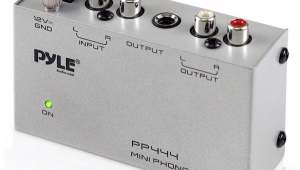Conrad-Johnson Premier 15 phono preamplifier Measurements
The Premier 15 was noninverting, as specified, and its voltage gain at 1kHz was also to spec at 53.25dB, with a 0.04dB difference between channels—which is superb matching, considering the lack of any loop negative feedback. As used by MF, the review sample was set to 47k ohms input impedance; I actually measured 41.5k ohms. The output impedance was slightly higher than specified, at 323 ohms at 20kHz and 328 ohms at 1kHz, with a rise to 1602 ohms at 20Hz. The line preamplifier with which the Premier 15 is partnered should have as high an input impedance as possible if you don't want a "lean" balance. The 12.5k ohms offered by Conrad-Johnson's own ART preamp is about as low as you should go, I feel.
The Conrad-Johnson's RIAA error is shown in fig.1. The top two traces are with the unit's subsonic filter switched out, the bottom pair with it switched into circuit. As well as rolling off the bass (-3dB around 16Hz), the filter drops the overall level by 0.5dB. Otherwise, the Premier 15's response is very flat, the preamp easily meeting its RIAA specification. Channel separation (fig.2) was only fair, but still better than any phono cartridge. Some high-frequency spuriae could be seen riding on top of the crosstalk, but this was well down in level.

Fig.1 Conrad-Johnson Premier 15, RIAA error into 100k ohms at 5mV/1kHz input (right channel dashed, 0.5dB/vertical div.). Bottom traces are with subsonic filter switched into circuit.

Fig.2 Conrad-Johnson Premier 15, crosstalk (from top to bottom): L-R, R-L (5dB/vertical div.).
Despite its use of tubes, the C-J's noise levels were acceptably low, at least when referred to a 10mV input signal at 1kHz: 68dB unweighted (10Hz-500kHz bandwidth), 71dB unweighted (22Hz-22kHz bandwidth), and 90dB A-weighted. These figures were for the left channel, the right channel being around 3dB quieter. Fig.3 shows a wideband spectral analysis of the Premier 15's noise floor, again referenced to a 10mV/1kHz input level. There is a rise in noise at low frequencies due to the gain stage following the RIAA equalization, but the noise is otherwise low in level. Some AC components can be seen in this graph—180Hz in the left channel, 120Hz in the right channel, 60Hz in both—but these are still sufficiently low not to be a problem.

Fig.3 Conrad-Johnson Premier 15, spectrum of noise floor ref. 10mV input at 1kHz (right channel dashed).
Distortion levels were below 0.1% into 100k ohm loads, but rose drastically into loads of less than 1k ohm or at high levels, and less so at the edges of the audio band. Fig.4, for example, shows the spectrum of the C-J's output while it drove 50Hz at a very high level (3.3V) into 100k ohms. Even so, the only significant distortion components present are the second harmonic (100Hz) and third harmonic (150Hz), at 0.3% and 0.03%, respectively. Considering the complete absence of negative feedback other than what's inherent in the output cathode-follower stage, this is astonishingly linear behavior. But again, the Premier 15 needs to see a line preamplifier with a high input impedance if that superb linearity is not to be compromised.

Fig.4 Conrad-Johnson Premier 15, spectrum of 50Hz at 3.3V RMS into 10k ohms.
Finally, fig.5 shows the preamp's THD+noise percentage plotted against its output voltage. The apparent reduction in THD as the signal level rises toward 1V is due to the noise increasingly becoming a smaller fraction of the THD+N figure. This is followed by a "knee" in the trace representing the unit's residual distortion level, and a rise as the circuit becomes less linear with increasing level. The leftmost trace is for 20Hz, followed by 20kHz and 1kHz. With typical MC cartridges, the Premier 15 will not be asked to deliver an output signal that will drive it into significant nonlinearity. The overload margins, assuming a typical MC output level of 500µV at 1kHz, are 10mV, 46dB (20Hz); 63mV, 42dB (1kHz); and 310mV, 35.9dB (20kHz)—all superb figures, and the best I have ever measured. Although I assume it has been optimized for use with MC cartridges, this phono stage has sufficient high-level linearity to work with typical MM cartridges.

Fig.5 Conrad-Johnson Premier 15, distortion (%) vs output voltage (V) into 100k ohms with (l-r) 20Hz, 20kHz, and 1kHz signals.
It is always a pleasure to measure a component that has so obviously been designed by engineers who know what they're doing. Such was the case with Conrad-Johnson's Premier 15 phono stage.—John Atkinson
- Log in or register to post comments

















































